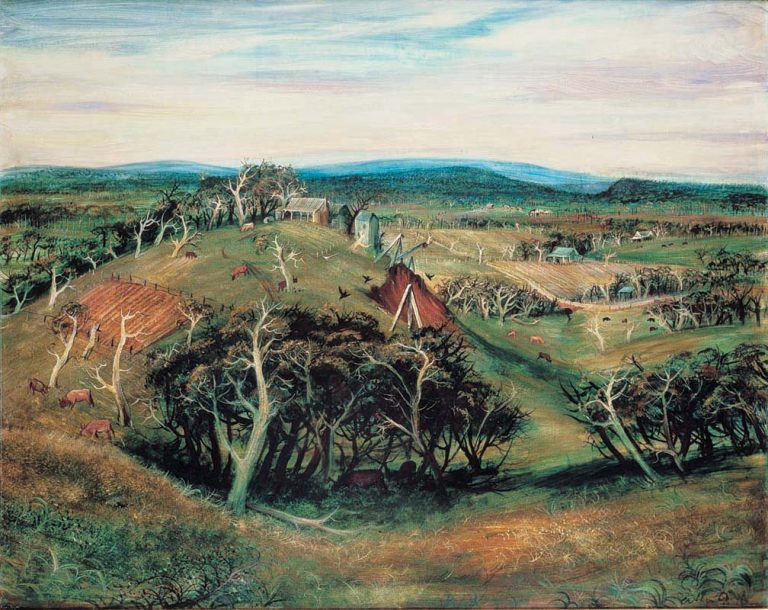We acknowledge the Traditional Owners of the land on which the Queensland Art Gallery | Gallery of Modern Art stands and recognise the creative contribution First Australians make to the art and culture of this country.

Arthur Boyd / Australia 1920–99 / Berwick landscape 1948 / Tempera on composition board / 69.6 x 87.4cm / Purchased 1977 / Collection: Queensland Art Gallery | Gallery of Modern Art / © Arthur Boyd Estate
Arthur BoydBerwick landscape 1948
Not Currently on Display
The jewel-like surface of Arthur Boyd’s Berwick landscape 1948 reflects the lush landscape of Berwick, Victoria, but with a subtle menacing undertone reminiscent of sixteenth-century Netherlandish painter Pieter Bruegel the Elder.
Viennese-born art historian Franz Philipp, in his 1967 monograph Arthur Boyd, describes Boyd as a born landscapist, but he connects this painting to English Romantic painter John Constable due to the way it responds to the landscape.
Boyd’s study of European old masters extended his capacity to encompass both the intimate and the panoramic in his landscapes, exemplified here. His early works were naturalistic landscapes in the Heidelberg impressionist tradition. Later, he was influenced by Modernism, Surrealism and Expressionism.
Arthur Boyd is arguably the most pictorially and creatively inventive of the twentieth-century Australian painters.
Born in 1920 in the Melbourne suburb of Murrumbeena, he entered into a family of painters, printmakers, potters and sculptors. From the age of 14 he lived at Rosebud on Victoria’s Mornington Peninsula, with his grandfather, landscape painter Arthur Merric Boyd. It was here that he began to paint full-time. Boyd was conscripted into the army in 1941 and, though he did not actively serve in World War Two, the influence of war on his work is evident in the symbolism and atmosphere of psychological torment throughout his oeuvre.
During his travels through central Australia in 1953, Boyd was exposed to the disparity of living conditions between Indigenous and white Australians. In 1959 he moved to England, returning to Australia in 1968. His 1973–88 paintings were chosen as the first to be exhibited in the new Australian Pavilion at the 1988 Venice Biennale.
Discussion Questions
1. What is meant by the term ‘masters’ when it comes to art?
2. Where can you see influences of Modernism, Surrealism and Expressionism in this painting?
Classroom Activities
Research the Heidelberg School. Write a short essay to outline how the Heidelberg impressionist tradition differed from Impressionism in general.